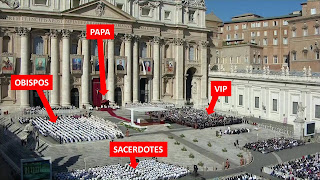|
JUBILEE YEAR for the CENTENNIAL of BLESSED
ROMERO, 2016 — 2017
|
||
|
|
||
The logistics
of the canonization ceremony for Pope Paul VI, Archbishop Oscar Romero and
others, have become clearer after the publication of instructions from the
dioceses of Brescia (headquarters for Pope Montini’s
cause) and San Salvador (for the Salvadoran martyr).
According to the guidelines, the Vatican will allow the dioceses of origin to
organize the attendance of their devotees, granting each one a block of
entrance tickets to the ceremony to distribute to their groups of faithful; the
Archdiocese of San Salvador will have 2,500 seats in an assigned area during
the ceremony.
Large images
of the seven new saints will decorate the façade of St. Peter's Basilica. Paul
VI and Archbishop Romero (photo) will occupy the central
place, as they have done in the press; the Pope on the left, and the martyred
archbishop on the right; the two surrounded by five more saints. Salvadoran
President Salvador Sanchez Ceren will attend the ceremony and will be seated in
the VIP section, to the right of the papal altar. In the same area Cecilia
Maribel Flores de Rivas and her family will also be seated—they are the
beneficiaries of the miracle that made the canonization possible;
also, Romero’s two surviving brothers and other relatives.
The seating
section on the left side will be reserved for bishops, including the entire Salvadoran
bishops’ conference. The ceremony will take place during a synod of bishops,
which means that many bishops from around the world will be present: the 2015 synod
was attended by more than 250 bishops. If
Romero’s canonization in Rome and not in El Salvador as his people wanted
counts for something, it will be to sear the image of Romero in the minds of
the world’s bishops gathered there. In front of the bishops, the front rows
in St. Peter's Square will be designated for concelebrating priests, who will
also be numerous.
It is
expected that between 70,000 and 120,000 faithful may attend, judging by the
turnout at recent similar ceremonies. The faithful must obtain entrance tickets
from the Archdiocese of San Salvador (they will not be distributed in travel
agencies, as had been supposed here). They must acquire their entrance tickets in the remaining
portion of June and throughJuly, registering as “pilgrims” with the
Archdiocese, which has published registration forms according to several
categories (unless otherwise noted, all forms are in Spanish):
The tickets
will be distributed to those registered (through group organizers) on the
Saturday before the ceremony, between 3 and 6 in the afternoon, on the right
side (seen from the front) of the Colonnade of St. Peter’s Square. With their
tickets in hand, the pilgrims must appear on Sunday 14 at 7 in the morning to proceed
to their designated places in an orderly fashion.
During the
ceremony, Romero will become the twelfth ever saint born in the Americas. His
official title will be “Saint Oscar
Arnulfo Romero, Bishop and Martyr,” although for many he is already “Saint Romero of the Americas”.








